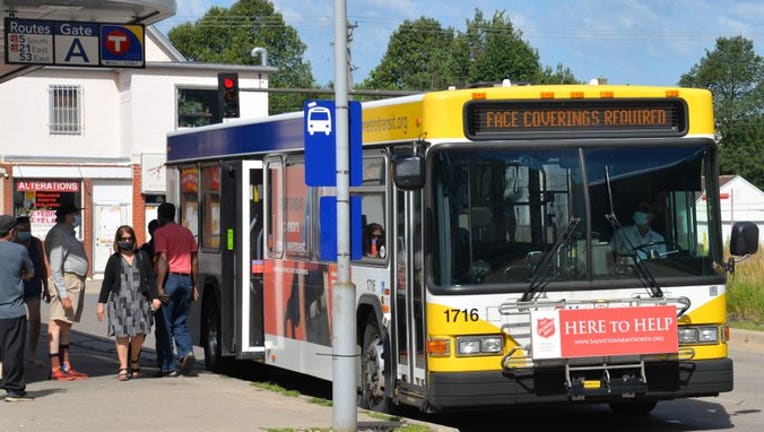How transit services in the Twin Cities have adapted for safety during COVID-19

Metro Transit, and other Twin Cities bus services, have implemented several safety protocols in response to COVID-19. (Metro Transit)
(FOX 9) - In recent months, the pandemic has forced several transportation companies rethink safety and sanitation protocols.
Metro Transit, and other transit services, have implemented several safety protocols to keep drivers and riders safe during the COVID-19 pandemic.
If you take the bus or train around the Twin Cities metro area, here's what you can expect when you ride.
Metro Transit
Metro Transit will return to front-door boarding and require onboard far payments starting Saturday, August 1.
All buses now have plexiglass shields to protect drivers and customers, according to the Metro Transit’s website.
Metro Transit is encouraging riders to pay with a touch-free Go-To Card or the Metro Transit app. Cash is still accepted.
To increase social distancing, Metro Transit said all customers, except those with mobility devices or special needs, should exit through the back door.
Face coverings for every rider ages two and up are required on all buses and trains.
If a bus does not have enough space for social distancing, the driver will display “Next Bus Please” on the overhead sign, and customers will need to wait for the next trip, according to Metro Transit’s website.
Prior to August 1, riders would board the bus through the back door only to prevent the spread of COVID-19.
The Metro Transit’s reduced service schedule can be found here.
Minnesota Valley Transit Authority
The Minnesota Valley Transit Authority will resume fare collections Saturday, August 1. MTVA encourages customers to use Go-To cards when possible.
MVTA’s safety measures include installed partitions between the driver and fare box to protect customers and drivers; enhanced cleaning, sanitizing, and disinfecting procedures; daily air filter changes; social distancing; closed transit stations and park and ride facilities; and removal of paper products and pocket schedules to reduce material handling.
Customers are expected to comply with the face mask requirement, limit touching of surfaces, social distance, and exit from the rear door when possible.
MVTA’s current service schedule can be found here.
Maple Grove Transit
Maple Grove Transit begins front-door bus boarding and full fare collection August 3, according the service’s latest rider alerts.
Maple Grove Transit is asking risers to enter all buses through the front door and exit the rear door for inbound (pay enter) trips and the front door for outbound (pay leave) trips. Touch-free payments are encouraged.
Riders are required to wear a mask. Masks will be provided if needed. The overall bus capacity is limited to 15 riders, and riders are expected to social distance.
The MY RIDE service, an advance reservation shared-ride service, is also open with the bus capacity of 1-3 riders to keep social distancing. The service is available to pick up groceries at Maple Grove stores and deliver them to homes.
Plymouth MetroLink
Plymouth Metrolink has implemented a range of safety measures throughout the pandemic, according to the City of Plymouth.
Drivers receive temperature checks and evaluations when they report to work. Buses and facilities are regularly disinfected. Driver barriers are being installed, and cabin air filters have been installed on all buses.
All drivers and passengers are required to wear masks. Masks are available for passengers who do not have one.
Plymouth Metrolink’s reduced service schedule can be found here.
SouthWest Transit
The SouthWest Transit has implemented several safety measures in response to COVID-19.
Safety protocols include cleaning buses and stations multiple times daily, limiting bus capacity, marking station floors for social distancing, and routinely changing cabin air filters.
All drivers and riders are required to wear masks. Masks will be provided as well.
View the SouthWest Transit reduced service schedule here.

